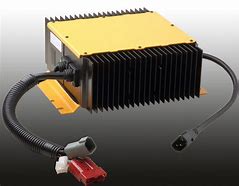Battery charging usually accomplishes two tasks, the first is to restore the rated capacity of the battery as quickly as possible, and the other is to use low current charging to replenish the energy lost by self-discharge to maintain the rated capacity of the battery. During the charging process, the lead sulfate on the negative plate of the lead-acid battery gradually precipitates lead, and the lead sulfate on the positive plate gradually generates lead dioxide. When the lead sulfate on the positive and negative plates completely produces lead and lead dioxide, the battery begins to overcharge, producing hydrogen and oxygen. Thus, in a non-sealed battery, the water in the electrolyte will gradually decrease. In a sealed lead-acid battery, hydrogen and oxygen can recombine into the water when a moderate charging rate is used. The time of onset of overcharge is related to the rate of charging. When the charging rate is greater than C/5, the overcharge reaction starts before the battery capacity returns to 80% of the rated capacity. Only a charging rate less than C/100 can cause the overcharge reaction to occur after the battery capacity has recovered to 100%. In order for the battery capacity to return to 100%, a certain amount of overcharge reaction must be allowed. After the overcharge reaction occurs, the voltage of the single-cell battery rises rapidly, and after reaching a certain value, the rate of rising decreases, and then the battery voltage begins to fall slowly. It follows that the best way to maintain the capacitance capacity after the battery is fully charged is to add a constant voltage at both ends of the battery pack. Float charging voltage, the charge current should be able to supplement the energy lost due to the self-discharge of the battery. The float charging voltage should not be too high to avoid shortening the battery life due to severe overcharging. Using the appropriate float charging voltage, the life of sealed lead-acid batteries can be more than ten years.

The practice has proved that when the actual float charging voltage is 5% different from the specified float charging voltage, the life of a maintenance-free battery will be shortened by half. The voltage of a lead-acid battery has a negative temperature coefficient, and its single cell value is -4mV/℃. The common (no temperature compensation) electric car charger that works ideally at an ambient temperature of 25°C will not fully charge the battery when the ambient temperature drops to 0°C. When the ambient temperature rises to 50°C, the battery will shorten its life due to severe overcharging. Therefore, in order to ensure that the battery is just fully charged over a wide temperature range, the various conversion voltages of the electric vehicle charger must vary with the temperature coefficient of the battery voltage.
Several common charging modes are
1. current-limited, constant-voltage charging mode
2. two-stage constant-current charging mode
3. constant current pulse charging mode
Several common problems with electric vehicle charging.

1. Blown fuse tube
A blown fuse tube indicates that there is a short circuit or overcurrent fault in the internal circuit of the electric vehicle charger. This is due to the charger working for a long time in a state of high voltage and high current, and the failure rate of internal devices is higher. In addition, fluctuations in grid voltage and surge can cause an instantaneous increase in current within the charger and make the fuse blow.
2. Cooling fan does not turn; this failure is mainly to the control of the fan of the transistor (generally 8550 or 8050) being damaged, the fan itself being damaged, or the wind blade being stuck in debris. But some chargers, Shen is using intelligent cooling. For the use of this way of cooling the charger, the probability of damage to the thermistor is very large.
3. DC voltage output is too high
This failure is often caused by voltage regulator sampling and voltage regulator control circuit abnormalities. In the electric car charger, DC output, sampling resistor, error sampling amplifier, optocoupler, a power control chip, etc., together constitute a closed control loop. Any one of the problems will lead to a higher voltage.
For the use of electric car chargers and customization, we should pay attention to the above points and want to customize and purchase, etc. Welcome to our company. Our company specializes in electric car charging, and lithium battery chargers, is to make your electric car use a longer time.
Next:How to control the charging of electric car charger
Previous:Lithium battery charger knowledge lithium battery requirements for chargers
Contact Person: Miss. Kiki
| WhatsApp : | +8617763224709 |
|---|---|
| Skype : | +8617763224709 |
| WeChat : | +8617763224709 |
| Email : | kiki@lifepo4-battery.com |